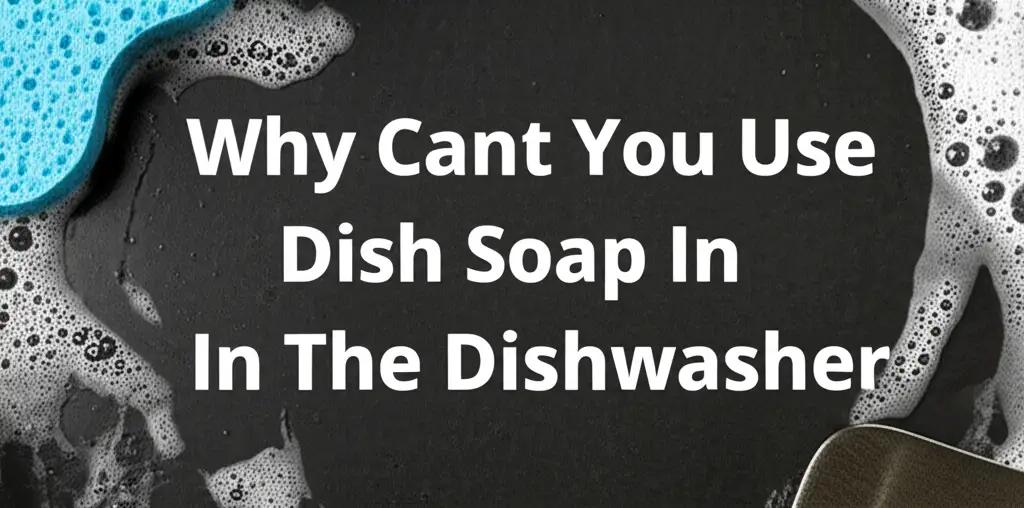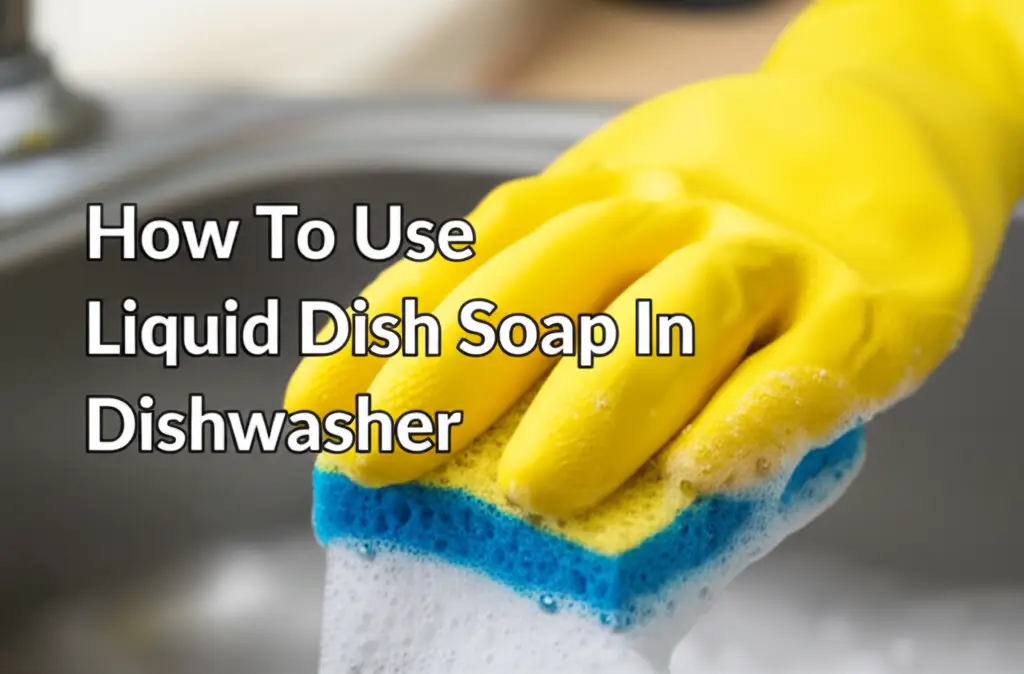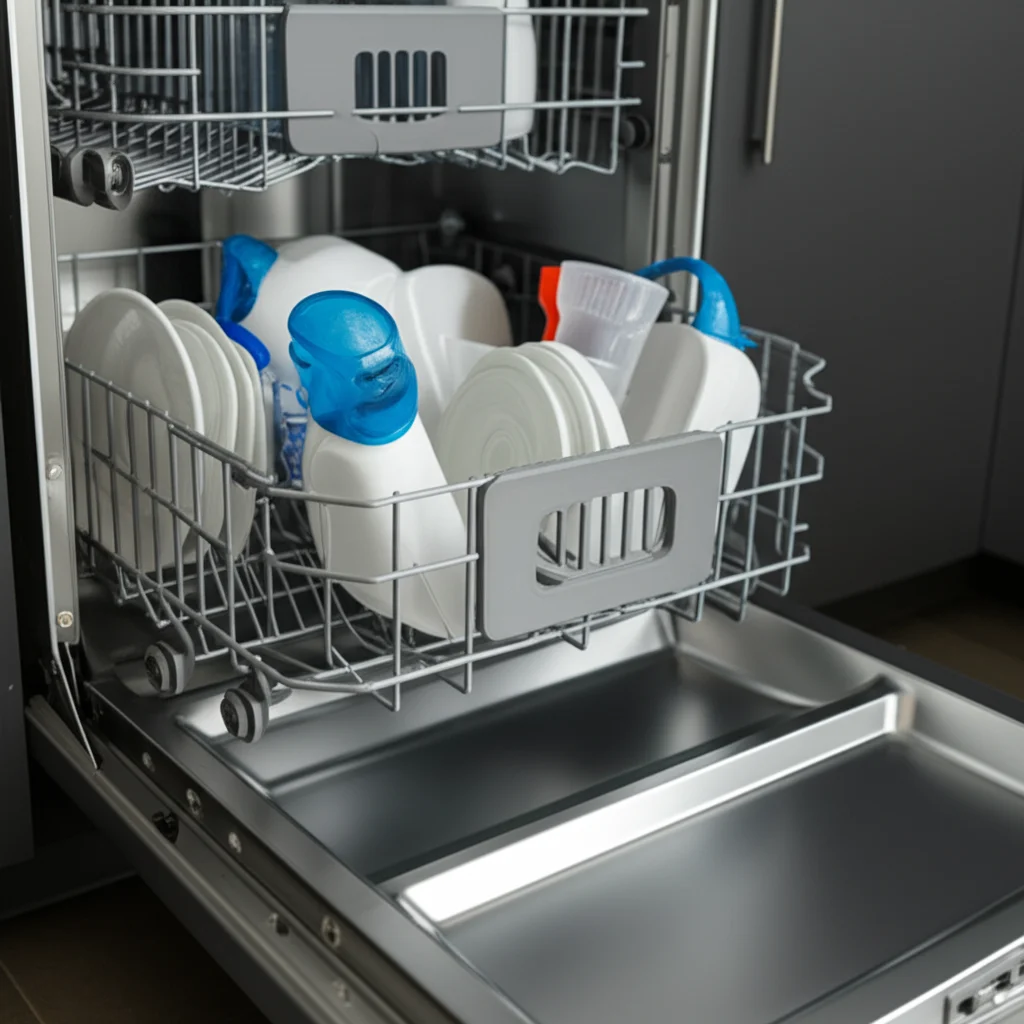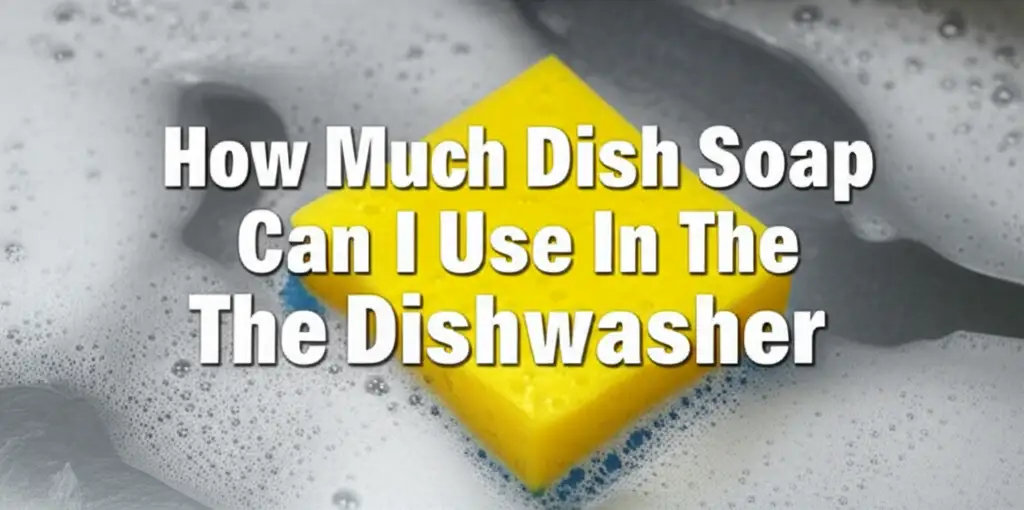· Davia Murnell · Kitchen & Home Appliances · 19 min read
Why Cant You Use Dish Soap In The Dishwasher

The Foamy Fiasco: Why You Can’t Use Dish Soap in Your Dishwasher
Imagine waking up to a kitchen floor covered in suds. It sounds like a scene from a movie, right? But this could be your reality if you ever decide to pour regular dish soap into your dishwasher. Many people wonder, “Why can’t you use dish soap in the dishwasher?” It seems like a logical shortcut when you run out of specialized detergent. However, this common mistake leads to big problems.
This article will explain the core differences between hand dish soap and dishwasher detergent. We will explore the specific issues that arise from using the wrong product. You will understand how excessive foam damages your appliance and what happens during a dishwasher cycle. We will also give clear steps to take if you make this mistake. Finally, we will share how to keep your dishwasher running well with the right products and care. Let’s keep your kitchen clean and your appliance safe.
Takeaway
- Never use hand dish soap in a dishwasher. Hand dish soap creates too much foam, leading to overflow.
- Dishwasher detergent is formulated for low suds. It cleans dishes through chemical action, not bubbles.
- Excess foam harms your dishwasher. It can damage the motor and other internal components.
- Accidental use requires quick action. Stop the cycle, scoop out foam, and run rinse cycles.
- Use only specific dishwasher detergents. This protects your appliance and ensures clean dishes.
You cannot use dish soap in the dishwasher because it creates excessive suds. Hand dish soap is designed to foam heavily, but dishwashers need low-sudsing detergent. This high foam volume causes overflows, damages appliance parts like the motor, and leaves a sticky residue on dishes.
The Fundamental Differences: Dish Soap vs. Dishwasher Detergent
Have you ever thought about why there are two different types of soap for washing dishes? We have hand dish soap for the sink and dishwasher detergent for the machine. They both clean dishes, but their formulas are very different. Understanding these differences is key to knowing why you cannot use dish soap in the dishwasher. Each product has a specific job and a unique chemical design.
Hand Dish Soap’s Design
Hand dish soap, also known as liquid dish soap, is made to create a lot of suds. We like to see bubbles when we wash dishes by hand. This foam helps lift grease and food particles from surfaces. It also feels good on our hands as we scrub. Hand soaps contain high levels of surfactants. Surfactants are chemicals that reduce water’s surface tension. This allows water to spread out and mix with oils. The suds help trap dirt and suspend it in the water. We then rinse these suds and dirt away with clean water. This heavy foaming action is perfect for manual scrubbing. It is not suitable for a contained appliance.
Dishwasher Detergent’s Composition
Dishwasher detergent works differently. It is made to clean without making many suds. Instead, dishwasher detergent relies on a powerful mix of enzymes, bleaching agents, and low-foaming surfactants. Enzymes break down food particles like proteins and starches. Bleaching agents tackle tough stains, such as coffee or tea. The low-foaming surfactants help water spread and clean without creating a mountain of bubbles. These detergents are designed to work in the high-temperature, high-pressure environment of a dishwasher. They clean dishes through chemical reactions and powerful water jets, not through scrubbing with suds. For more details on the right amount to use, you can read about how much dish soap can I use in the dishwasher.
This fundamental difference in foaming ability is why using hand dish soap in a dishwasher is a big mistake. The machine cannot handle the amount of foam. The detergent in the dishwasher needs to rinse away cleanly without leaving residue. Hand soap’s foaming power means it sticks around. You can find more information about why you cannot use regular dish soap in a dishwasher by reading can I use normal dish soap in the dishwasher.
Understanding the Suds: Why Excessive Foam Creates Problems
Have you ever imagined your kitchen floor filled with bubbles? That is often the first and most visible sign of using hand dish soap in a dishwasher. The machine is not built to handle large amounts of foam. When hand soap enters the dishwasher, it creates a suds explosion. This is because dishwashers use powerful water jets and circulate water aggressively. These actions whip up the hand soap into a massive volume of foam. This foam quickly becomes a serious problem.
The Overflow Hazard
The most immediate issue is the overflow. Dishwashers have specific water levels for their operation. They also have seals and vents to keep water inside. When too much foam builds up, it expands rapidly. This foamy mass quickly fills the entire inside of the dishwasher. The foam then pushes past the door seals and out through the air vents. You will see suds pouring out onto your kitchen floor. This creates a messy and potentially dangerous situation. The floor becomes slippery. Water can seep into cabinets, causing damage to wood or flooring. It is a cleaning nightmare you want to avoid.
Foam Trapping Food Particles
Beyond the physical mess, the excessive foam also hinders the cleaning process itself. The purpose of a dishwasher is to remove food particles from your dishes. It then washes them down the drain. However, a dense layer of foam traps these particles. It acts like a sticky blanket. The spray arms cannot effectively rinse dishes because of the foam. Food bits get suspended in the bubbles and cling to your dishes. Instead of being washed away, dirt gets redeposited onto other items. Your dishes come out looking cloudy, spotty, or even still dirty. They may also have a soapy film. The foam also makes it hard for the machine to drain properly. It becomes a cycle of poor cleaning.
Beyond the Bubbles: The Risks of Dish Soap Damage to Your Dishwasher
The immediate mess from a dish soap overflow is just one part of the problem. Using hand dish soap in your dishwasher can also cause serious damage to the appliance itself. Dishwashers are complex machines with many moving parts. They rely on precise operations to clean effectively. The wrong type of soap can disrupt these operations and lead to costly repairs. It is important to understand these hidden risks.
Internal Component Corrosion
Dishwasher components are made from materials designed to withstand harsh detergents and hot water. However, hand dish soap is not part of this design. The chemicals in hand soap are different. They can corrode or degrade internal parts over time. For example, the seals and gaskets in a dishwasher are often rubber or plastic. They prevent water leaks. Hand soap residues can break down these materials. This causes seals to become brittle or leaky. Pumps and spray arms also suffer. These parts are usually metal. The soap can cause rust or wear faster than normal. This leads to reduced cleaning performance and eventual leaks.
Clogged Drains and Filters
Hand dish soap does not rinse away cleanly like dishwasher detergent. It leaves behind a sticky residue. This residue builds up in the dishwasher’s drain system and filters. Over time, this sticky film collects food particles and mineral deposits. It creates thick clogs. A clogged filter reduces water flow, leading to dirty dishes. A clogged drain pump prevents water from leaving the machine. This results in standing water in the bottom of the dishwasher. Clogs can also put stress on the dishwasher’s motor. This causes it to work harder and potentially overheat. Regular use of hand soap quickly ruins these vital systems.
Motor Strain and Failure
The most severe damage from using hand dish soap can occur to the dishwasher’s motor. The motor powers the spray arms and the drain pump. It moves water around the tub and out of the machine. When excessive suds fill the dishwasher, the motor has to work much harder. It tries to pump water, but it mainly pumps foam. Foam is much harder to push than water. This extra strain puts immense stress on the motor. It can cause the motor to overheat or even burn out completely. Replacing a dishwasher motor is a very expensive repair. Sometimes, it costs more than buying a new dishwasher. This makes the accidental use of hand dish soap a very costly mistake. Preventing this kind of damage simply means using the correct detergent.
The Cleaning Mechanism: How Dishwashers Actually Work
Many people assume a dishwasher cleans like hand washing, but inside a tub. This is not true. Dishwashers use a very different method to get dishes clean. Understanding this process helps you see why specific dishwasher detergents are essential. It also makes it clear why hand dish soap is so harmful. Your dishwasher is a precise machine. It uses specific forces to clean, not just bubbles.
Water Jets and High Heat
A dishwasher primarily cleans using powerful jets of hot water. Inside your dishwasher, you will find spray arms. These arms have many small nozzles. When the wash cycle starts, a pump forces hot water through these nozzles. The water sprays out with high pressure. These powerful streams blast food particles off your dishes. The spray arms also spin, ensuring water reaches every corner and every dish surface. This mechanical action, combined with high water temperatures, breaks down and dislodges dirt. Most dishwashers heat water to very high temperatures. This hot water helps sanitize dishes and melt grease. Hand scrubbing is not part of the design.
Detergent Dispenser Role
The dishwasher detergent plays a crucial role in this process. It is released at specific times during the wash cycle. The detergent dispenser opens, usually during the main wash cycle. The detergent then mixes with the hot, high-pressure water. This mixture then circulates around the dishes. The chemicals in the detergent work to loosen food residue. Enzymes break down stuck-on food. Bleaches remove stains. Unlike hand washing, where soap creates suds to lift dirt, dishwasher detergent works chemically. It helps the hot water and pressure do their job more effectively. It relies on its chemical properties, not foam. For insights on running your machine efficiently, read how to use dishwasher.
Filtration and Draining
After the wash cycle, the dishwasher drains the dirty water. The machine has a filtration system to catch larger food particles. This filter prevents clogs in the drain pump and hoses. The dirty water then goes down the drain. Then, the dishwasher typically begins a rinse cycle. Fresh, hot water sprays again to remove any remaining food particles and detergent residue. Finally, the water drains again. Many dishwashers also have a drying cycle. This uses heat to evaporate any remaining moisture. The entire process is designed for water and specific chemicals. It is not designed to handle a foamy mess. Every step relies on clear water circulation and efficient drainage. This is why suds from hand soap cause such major problems for the machine.
Emergency Measures: What to Do If You Used Dish Soap Accidentally
It happens to the best of us. One day you are tired, distracted, or in a hurry. You reach for the wrong bottle and pour hand dish soap into the dishwasher. Don’t panic. While it is a messy situation, you can take steps to minimize the damage. Acting quickly is key to preventing major problems for your appliance and your kitchen. I understand this mistake can be stressful, but you can fix it.
Immediate Action Steps
The moment you realize your mistake, you need to act fast. First, stop the dishwasher immediately. If the cycle has already started, open the door. This will pause the machine. You will likely see a large amount of foam inside. Do not just close the door and hope it goes away. Next, you need to remove the foam. Use a large cup or a sponge to scoop out as much foam as you can. Do not try to just drain it, as it will just create more suds in your drain. This manual removal is essential. Try to get most of the visible suds out of the tub.
Cleaning Up the Overflow
If suds have already spilled onto your kitchen floor, clean them up quickly. Use towels or a mop to absorb the foam and water. Be careful, as the floor will be very slippery. Ensure no water seeps under cabinets or appliances. Water damage can be very costly. After removing the bulk of the foam, you will need to rinse the inside of the dishwasher. Close the door and run a quick rinse cycle without any detergent. This helps wash away remaining suds. You may need to run several rinse cycles. Keep an eye on the machine for more overflowing suds. Repeat the scooping and rinsing process until no more foam appears. Sometimes, adding a cup of white vinegar to the bottom of the dishwasher during a rinse cycle can help break down some of the remaining suds. For a full guide, check out how to fix putting dish soap in the dishwasher.
Preventing Future Issues
Once you have cleared all the suds, you should clean your dishwasher’s filter. The sticky soap residue and any trapped food particles will gather there. Remove the filter and rinse it thoroughly under hot water. You might need to use an old toothbrush to scrub away any film. After cleaning the filter, run an empty cycle with actual dishwasher detergent to ensure all soap residue is gone. This helps re-prime the system. To prevent this mistake from happening again, store your hand dish soap and dishwasher detergent in separate, clearly marked locations. This simple act reduces the chance of accidental misuse. Always double-check the label before adding anything to your dishwasher.
The Right Way: Using Proper Dishwasher Detergent for Optimal Results
Now that you know what not to use, let’s talk about what you should use. Using the correct dishwasher detergent is crucial for clean dishes and a long-lasting appliance. It is not just about avoiding problems. It is about getting the best performance from your dishwasher. There are many types of dishwasher detergents available. Choosing the right one and using it correctly makes a big difference.
Types of Dishwasher Detergent
Dishwasher detergents come in a few common forms. Each type has its own benefits.
- Powder: This is often the most economical option. It usually works well, especially for normal loads. You can adjust the amount based on how dirty your dishes are or your water hardness. However, powder can sometimes clump or leave residue if not stored correctly.
- Gel/Liquid: These detergents are easy to pour and dissolve quickly. They are generally less abrasive than powders. Some people find them less effective on very tough stains. Gels might also contain less powerful enzymes.
- Pods/Packs: These pre-measured packets are very convenient. You simply put one pod into the dispenser. They contain a mix of detergent, rinse aid, and sometimes other boosters. Pods eliminate guesswork about dosage. They are often more expensive per load but ensure consistent cleaning.
I generally prefer pods for their simplicity and effectiveness. They take the guesswork out of measuring.
Correct Dosage and Loading
Using the right amount of detergent is just as important as using the right type.
- For powders and gels: Check your dishwasher’s manual for recommended dosage. Most dispensers have fill lines. Adjust for water hardness (more detergent for hard water) and soil level. Too little detergent means dirty dishes. Too much can leave a film.
- For pods/packs: Always use one pod per load. Do not use more, even for very dirty loads. The chemicals in pods are highly concentrated.
Proper loading also impacts cleaning.
- Do not overcrowd: Give water and detergent space to circulate.
- Face dirty surfaces inward: Ensure spray arms can hit all food particles.
- Separate items: Prevent nesting, especially with bowls and spoons.
- Place plastics on the top rack: High heat can warp plastics on the bottom.
The Importance of Rinse Aid
Many people overlook rinse aid, but it is vital for sparkling dishes. Rinse aid works by reducing the surface tension of water. This allows water to sheet off dishes rather than forming droplets. Droplets dry and leave water spots, especially in hard water areas. Rinse aid also helps dishes dry faster. Most dishwashers have a separate dispenser for rinse aid. You fill it up, and the machine dispenses a small amount during the final rinse cycle. Using rinse aid ensures your dishes come out clean, dry, and spot-free. It adds a final polish to your wash cycle, making your efforts truly pay off.
Protecting Your Investment: Long-Term Care for Your Dishwasher
Your dishwasher is a hardworking appliance. It saves you time and effort every day. Just like any other major appliance, it needs regular care and maintenance. This ensures it runs efficiently and lasts for many years. Proper care goes beyond just using the right detergent. It involves simple, routine steps that protect your investment and prevent future problems. I believe a little care goes a long way.
Regular Cleaning of Filters
One of the most important maintenance tasks is cleaning your dishwasher’s filter. The filter catches food scraps and debris that wash off your dishes. If the filter becomes clogged, water cannot flow freely. This results in poor cleaning performance and dirty dishes. It also puts extra strain on the dishwasher’s pump.
- Locate the filter: Most dishwashers have a removable filter at the bottom of the tub. Refer to your appliance manual if you cannot find it.
- Remove and rinse: Twist or unclip the filter and pull it out. Rinse it under warm running water to remove all food particles. You may need an old toothbrush to scrub away stubborn residue or grease.
- Frequency: Clean your filter at least once a month. If you wash a lot of dishes with heavy food residue, you might need to clean it more often.
This simple step prevents many common dishwasher issues.
Descaling and Deep Cleaning
Over time, mineral deposits from hard water can build up inside your dishwasher. These deposits, along with grease and detergent residue, can affect cleaning performance and leave a cloudy film on dishes.
- Use a dishwasher cleaner: Once a month or every few months, run an empty cycle with a specialized dishwasher cleaner. These cleaners target mineral buildup and grime.
- Vinegar method: Alternatively, you can use white vinegar. Place a dishwasher-safe bowl filled with one cup of white vinegar on the top rack. Run a hot cycle without any dishes or detergent. The vinegar helps break down mineral deposits and deodorizes the machine. Do not use vinegar if you have just cleaned with a chlorine bleach-based cleaner, as it can create harmful fumes.
- Baking soda for odors: If your dishwasher smells, sprinkle one cup of baking soda on the bottom of the tub. Let it sit overnight, then run a short hot cycle in the morning.
These deep cleaning steps keep the internal parts clean and free of buildup.
Checking Seals and Hoses
Leaks are a common problem for dishwashers. Regular checks of the door seal (gasket) and hoses can prevent messy and costly water damage.
- Door seal: Inspect the rubber gasket around the dishwasher door. Look for cracks, tears, or signs of wear. A damaged gasket can cause leaks. Wipe it down regularly to remove food particles or residue that can prevent a tight seal.
- Hoses: Periodically check the water supply and drain hoses connected to your dishwasher. Look for kinks, cracks, or signs of bulging. If you see any damage, contact a professional for replacement. Hoses can degrade over time and cause significant leaks.
By performing these simple maintenance tasks, you extend the life of your dishwasher. You also ensure it continues to clean your dishes effectively. This proactive approach saves you from expensive repairs and ensures your kitchen remains a clean and functional space.
FAQ Section
What happens if I accidentally put dish soap in the dishwasher?
If you accidentally put dish soap in the dishwasher, it will create excessive suds. These suds will expand rapidly, likely causing an overflow onto your kitchen floor. The foam can also damage the dishwasher’s motor, clog filters, and leave a sticky film on your dishes, making them appear dirty.
Can I use a small amount of dish soap in the dishwasher?
No, you should never use any amount of hand dish soap in the dishwasher. Even a very small amount will create far too many suds for the machine. Dishwashers are not designed to handle foaming agents. Any amount will result in an overflow and potential damage to the appliance.
Is there a substitute for dishwasher detergent?
There are no safe or effective substitutes for commercial dishwasher detergent. Household items like baking soda or vinegar can be used for cleaning the dishwasher itself, but they cannot replace detergent for washing dishes. These items lack the powerful cleaning agents needed to break down food and grease in the dishwasher’s unique environment.
How do I clean up a dish soap overflow?
To clean up a dish soap overflow, immediately stop the dishwasher cycle and open the door. Use a cup or sponge to manually scoop out as much foam as possible from the tub. Then, run several rinse-only cycles to clear remaining suds. Clean any spilled foam from your kitchen floor to prevent slips and water damage.
Will dish soap damage my dishes?
While hand dish soap won’t immediately damage your dishes, it will leave them covered in a cloudy, soapy film. This film can make dishes appear dirty and may require re-washing by hand. Repeated exposure might also dull certain finishes on glassware or dishes over time.
Why is dishwasher detergent different from hand dish soap?
Dishwasher detergent is formulated to be low-sudsing and contains powerful enzymes and bleaching agents that clean dishes through chemical reactions in hot water. Hand dish soap, however, contains high levels of foaming agents (surfactants) designed to create suds for manual scrubbing. Their chemical compositions and purposes are entirely different.
Conclusion
It is clear now why you cannot use dish soap in the dishwasher. This common mistake leads to a sudsy disaster, potential appliance damage, and dirty dishes. Hand dish soap and dishwasher detergent are fundamentally different products. Hand soap is made for bubbles and manual scrubbing. Dishwasher detergent is designed for low foam, chemical action, and the specific mechanics of your machine.
Remember, the overflow of suds is just the beginning. The real danger lies in the strain on your dishwasher’s motor, the corrosion of internal parts, and the clogging of essential filters. These issues can lead to expensive repairs or even require buying a new appliance. If you make the mistake, act quickly. Stop the cycle, scoop the foam, and run rinse cycles. Then, clean your dishwasher’s filter thoroughly.
To protect your appliance and ensure consistently clean dishes, always use detergent specifically made for dishwashers. Choose from powders, gels, or convenient pods. Understand proper loading techniques and consider using rinse aid for sparkling results. Regular maintenance, like cleaning filters and checking seals, will also extend your dishwasher’s life. By following these simple guidelines, you can keep your kitchen clean, your dishes spotless, and your dishwasher running smoothly for many years to come. Make the smart choice for your home.





